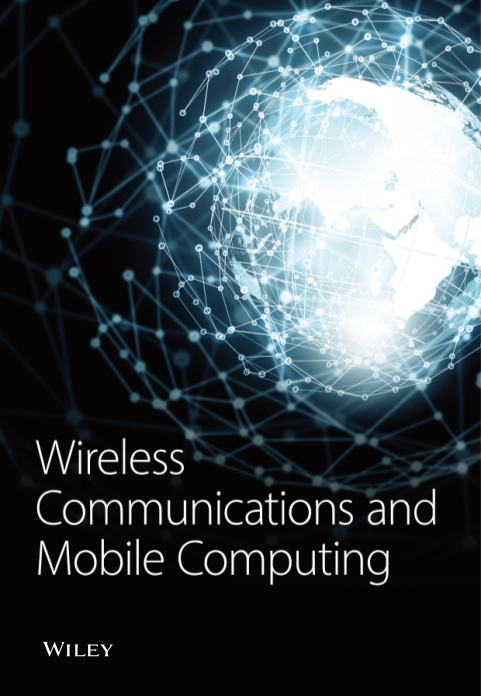RETRACTED: Scenic Tourist Route Planning Algorithm Based on Mobile Computing and Grey Entropy Decision Model
Abstract
Since the concept of “Smart Earth” was put forward, countries have attached great importance to the research and introduction of smart tourism. With the increasing updating of information technology, the tourism industry is also constantly trying to transform intelligently, and the personalized recommendation of its travel routes has become the most important development in smart tourism, one of the hot topics. Tourism agencies create traditional travel itineraries based on the preferences of the majority of people and the characteristics of tourist attractions. These lines are primarily used for team travel. People’s expectations for travel route planning are increasing as their living standards rise, and the traditional route planning algorithm based on a static road network data model has struggled to describe the complex and changing scenic environment. The improved random walk algorithm suggests suitable travel routes to users, allowing for more accurate route recommendations and effectively addressing the problem of new route recommendation difficulty. This paper proposes a scenic tourist route planning algorithm using the grey entropy decision-making model and mobile computing. The content of the recommended results is more closely related to the target recommendation user’s tendency after personalized adjustment, which has a better effect on the personalization of the recommended results.
1. Introduction
Tourism has become one of the largest industries in the world and is growing faster and faster. As one of the three pillar industries of tourism, travel agencies have been expanding their market size in recent years, and the number of travel agencies has increased rapidly [1]. With the vigorous development of tourism, the characteristics of tourists’ tourism consumption are becoming more and more rational and personalized. How to find attractive tourism products has become an important issue that tourists, travel agencies, and tourism websites are concerned about.
Most tourism-related applications only recommend simple tourist attractions, and they are only based on the popularity of tourist attractions, according to applications related to tourist attraction recommendation and tourist route recommendation published in the current popular mainstream tourism portal websites, sorted by recommendations for popular tourist attractions [2]. The shortest path (optimal path) problem is a major research topic in computer graph theory [3], and the shortest path query has a wide range of applications in life, including logistics planning, traffic simulation, and travel. For inquiry, the traditional tourism industry’s operation mode and management are gradually transforming to informatization, intelligence, and personalization as modern information technology replaces it, fully reflecting the central role of computer information technology in the development of smart tourism. The online travel mode is quietly evolving; enterprise business models are clearly integrated, conflicted, and integrated; and industry competition is increasing [4]. Most existing methods only take into account one aspect of the user’s constraints, and most users’ travel routes are frequently hampered by factors such as cost, time, and transportation. It is difficult to meet real-world user needs with recommendations based on a single constraint. Travel routes of travel agencies are the specific forms of travel products of travel agencies. If travel agencies are the key and hub of the entire tourism market, then travel routes of travel agencies are the drivers that make the key and hub function. Smart tourism is based on traditional tourism methods, providing an intelligent service platform for tourism, focusing on personalized user experience and combining with a new generation of computer technology to form a huge tourism service system [5]. It is rare to recommend related tourist attractions involving the degree of association between scenic spots, and there is not a series of mature automated methods for self-service intelligent travel route recommendation, all of which rely on the travel experience of previous tourists to make travel routes. For planning and recommendations, with the development of social economy and the improvement of people’s living standards, tourism has become the most popular way of leisure in people’s spare time. An important method to solve information overload is personalized recommendation technology, which has been successfully applied to e-commerce, movies, music, and other territories, and has achieved good social and economic benefits. The main issue with existing travel websites is that the majority of the products they offer are travel products provided by travel agencies, and tourists are unable to participate in the planning of attractions, food, and lodging for their trip [6]. If a tourism organization has a large number of historical records, they can be used to group the best travel routes for different groups of people based on their age, income, and other factors. For tourism information services, the development of social network platforms has provided a wealth of data sources and sharing platforms. As a result, it is possible to obtain a more comprehensive and reasonable scenic spot evaluation by mining various information data of scenic spots on social networking sites, such as the opening hours of scenic spots and tickets, as well as the GPS coordinates of scenic spots. With the passage of time and the rapid advancement of science and technology, the world economy has entered a new era in which the supply of products and services has greatly increased, and the life cycle of products on the market has also been greatly shortened. Products are up against global competition. In the face of global competition, businesses begin to pay attention to customers, and academics begin to research the value that customers demand [7].
Smart tourism is based on the new generation of information technology to meet people’s individual needs for tourism products, while improving the quality and satisfaction of the tourism service industry [8]. For a new revolution in efficient applications, traditional recommendation systems generally mainly rely on user ratings, but the data in travel systems generally only have implicit feedback data such as browsing and booking, which need to be normalized before they can be used. Smart tourism is based on traditional travel services. However, smart tourism is not a direct extension of traditional tourism services. Smart tourism will provide people with a new service experience and a more convenient and efficient way to obtain information.
2. Related Work
Membership degree, nonmembership degree, and hesitation degree, as well as their internal relationships, were proposed in the literature [9] and then developed into intuitive fuzzy set (IFS). A new M-TOPSIS method is proposed in reference [10]. The extended VIKOR method and the TOPSIS method were proposed in reference [11] to solve the multiobjective decision-making problem of hesitant fuzzy set information, and an example was used to compare the advantages and disadvantages of the two methods. Reference [12] proposed a new fuzzy entropy of hesitant fuzzy language set and investigated its application in multiattribute decision-making when used in conjunction with the fuzzy TOPSIS method for supplier selection. A multiattribute team decision-making method based on a new decision reference point and prospect theory is proposed in reference [13]. Reference [14] proposed a concept based on the definitions of a positive ideal hesitant fuzzy set and a negative ideal hesitant fuzzy set and then applied it to a multiattribute hesitant fuzzy information decision-making method. A team decision model for contrastive languages based on hesitant language fuzzy sets was proposed in reference [15]. The linguistic expressions used for comparison are closer to the human cognitive model, and the team decision-making process and necessary methods to manage such linguistic expressions are defined based on linguistic preferences. In multiattribute team decision-making, reference [16] proposes an interval hesitant preference relation that takes into account differences of opinion among individual decision makers. Reference [17] suggests using regression analysis to ensure that the decision is neither random nor illogical and that the hesitant fuzzy preference relationship is highly consistent. Another generalized form of fuzzy set, the hesitant fuzzy set (HFS), was proposed in the literature [18], whose membership degree is a set composed of several possible values. Reference A-related method for multiattribute decision-making was proposed by [19]. Literature [20] proposed the grey fuzzy set, which is not only the generalization of the fuzzy set but also the generalization of the grey set and the organic combination of the grey set and the fuzzy set. Literature [21] proposed a grey fuzzy multiattribute decision-making method, which has attracted great attention. Literature [3] and others proposed a grey fuzzy multiattribute decision-making method under the closed-world framework. Literature [22] proposed the idea of boundary line area and proposed rough set, it attributed those unidentified individuals to the boundary line area, and this boundary line area was defined as the difference set between the upper approximate set and the lower approximate set. [23] proposes an equivalence relation R as a new predicate to expand the classical binary logic. Literature [24] proposed the approximate reasoning mode and the resolution principle of rough logic and so on. All these studies open up new avenues for the application of classical logic to approximate reasoning. Reference [25] proposed the concepts of ranking entropy and ranking mutual information and applied ranking mutual information as a heuristic to construct an ordered decision tree.
In this paper, the grey entropy decision-making model is used to plan tourist routes in scenic spots; how to use and process massive high-dimensional data to mine the most valuable knowledge has become one of the research topics of today’s data mining, machine learning, and computational intelligence. The decision-making model can make the conclusions drawn are more consistent with the expectations of consumers.
3. Contents of Tourist Route Planning
3.1. Labeling and Pruning of Tourist Routes
How to intelligently provide personalized services for tourists has become an urgent problem to be solved, given the explosive growth of tourism information and complex and diverse tourism needs. With the rapid growth of location-based social networks, an increasing number of users are sharing their location information and leaving comments on specific locations on online social platforms alike. You can get detailed information about the user’s location and understand the user’s real-world behavior, personal preferences, and so on by mining these data. This user data can be used to provide more personalized location-based social networking services. With the tourism industry’s rapid growth, an increasing number of people will opt for vacation travel. In most cases, when a user arrives in a new city to visit, they will first look up tourism information for the city on the Internet in order to plan their own trip. The amount of data available is enormous and difficult to comprehend. Finding useful information that meets their actual needs from these data takes a long time and is very difficult for users. Travel route data is a type of crowdsourced geographic data that includes information such as travel time, travel duration, tourist attractions, types of tourist routes, and other information that can reflect tourist behavior patterns, travel preferences, and popularity of tourist attractions. It can be applied to the field of intelligent travel route recommendation with great success.
Existing research on team travel route search usually aggregates the preferences of multiple users, and then uses individual travel route search algorithms to search. In real life, when team users browse a tourist route as a whole, there are some individual users who need to choose different local attractions to visit according to their own preferences. Tourists tend to adopt personalized tourist routes, and planning such routes requires comprehensive consideration. Path length, path cost, and points of interest covered by path. Keyword coverage optimal path query (KOR) is a kind of query used to plan such a route, and its processing usually includes preprocessing and path expansion. With the development of the Web 2.0 era, the label data in the social network continues to emerge, which promotes the innovation of recommendation methods from collaborative filtering recommendation to label recommendation. In real life, when there are large differences in the preferences of team users who travel together, and it is difficult to find a peer route that satisfies all user preferences, it is hoped to find an optimal travel route that is locally distributed as a whole, that is, travel together when transferring between POIs. When visiting a specific POI, individual users can select the POI around the point and make the most profitable visit according to their own preferences. Tourist route search is a hot issue in the research of location-based social network services.
With the passage of time, the user’s perception of tourism consumption is becoming increasingly rational and personalized. The actual situation of the scenic spots, such as the scenic spot’s category, opening time, ticket price, transfer time and cost between the two scenic spots, and whether special teams (such as disabled, elderly, and students) are charged half price, will influence whether users visit the scenic spot to play. Tourist itinerary recommendation can mine the massive online tourist itinerary data for frequent sequences of tourist attractions with high tourist interest and popularity, provide guidance and reference suggestions for the tourist itinerary recommendation process, and greatly improve tourism. Route recommendation that is reasonable and cost-effective, reducing unnecessary expenses and travel fatigue. The memory overhead required for preprocessing existing algorithms has increased dramatically as the scale of road network graphs has continued to grow. Large-scale road networks cannot be processed due to a lack of memory; the search space for path expansion is rapidly expanding, and the scalability of application scenarios and query real-time Sex is difficult to ensure. In order to solve the above problems, we must first excavate the travel records, extract the tourist attractions in the records, and find out the relationship between the tourist attractions. Today’s tourism information services are developing in four directions: intelligent tourism, virtual tourism, e-commerce, and comprehensive tourism information systems. Route search effectively solves the issue of fairness in recommended routes when there is a large difference in team preferences and avoids the situation where the overall satisfaction of the team is high, and the individual benefits vary greatly, taking into account the benefits of teams and individuals, and enhancing the tourism of team users The experience effect is an effective supplement to the problem of team tourism route recommendation.
3.2. Mining of Popular Tourist Routes
With the continuous development of the national economy, holiday tourism has developed rapidly. Choosing to travel in leisure time such as vacation has become the first choice for many people for leisure, entertainment, and vacation. In the information age, with the rapid popularization of the Internet, the tourism industry has a huge space for development, and people increasingly hope to use the Internet to make tourism more intelligent. Travel route planning is a very important factor in self-service travel planning. Since the concept of “Smart Earth” was proposed, countries have placed a high priority on smart tourism research and implementation. The tourism industry is constantly trying to transform intelligently as information technology advances, and personalized recommendation of travel routes has become the most important development in smart tourism. One of the most talked about topics. In the last ten years, the development of Web technology, mobile Internet technology, and intelligent terminals has spawned a new concept known as “We-media,” a self-contained new mode of communication. In the face of numerous potential tourist attractions, limited time to visit, and unfamiliarity with the destination, many tourists face a common problem when formulating their travel itinerary: what kind of travel itinerary is better to achieve play with a goal in mind? More and better quality travel information obtained from the Internet can enhance people’s travel experiences and make travel planning and decision-making easier, making individualized free travel the mainstay of tourism development. Users can refer to and discuss itineraries on a variety of travel recommendation websites and forums on the Internet. Simultaneously, people can use the Internet to upload photos taken during the journey to an online album for everyone to see, as well as write travel notes to record the journey for others to learn from.
However, there is still a lot of room for improvement in the current research and application in related territories. Most recommendation algorithms are based on traditional collaborative filtering and association rules. The practicality of the recommendation results and the orientation of user interests need to be improved. There are also some recommendations. The system directly interacts with the user online and makes recommendations based on the user’s current interests, but this type of recommendation system has no self-learning ability and does not take into account the changing characteristics of the user’s interest characteristics. “We-media” has the characteristics of popularization, low threshold, fast dissemination, and strong interaction. Self-media travel information on the internet has a lot of mining and application potential. People suffer from a severe lack of knowledge and information as a result of being overwhelmed by the massive amount of data available on the Internet. For knowledge discovery, it is necessary to mine the vast amounts of data available on the Internet. Many tourists used to plan their trips by consulting friends or experts who had previously visited tourist destinations, or by asking locals for recommendations, or by browsing travel forums or blogs.
It takes a lot of time and effort to read, analyze these travel experiences, and develop a travel itinerary that suits your interests, so this paper is aimed at using user-generated data to automatically plan travel itineraries for users. It is necessary to find an appropriate way to visualize the results of information mining to help people enhance their cognition and give full play to the important role of visualization in data understanding. Tourism route planning based on user-generated data shows great research significance and value, and with the exponential growth of data volume year by year, the value of these image and text data mining will become more apparent. The algorithm flow of frequent scenic spot sequence mining is shown in Figure 1.
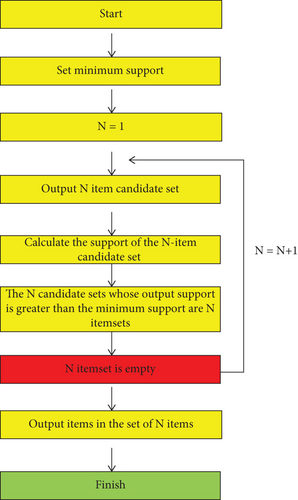
4. Scenic Tourist Route Planning Algorithm Based on Grey Entropy Decision Model
4.1. Fuzzy Sets and Fuzzy Rough Sets
Human beings solve a problem after comprehensively analyzing the decision-making environment, using scientific means and skills, through certain analytical thinking and judgment, according to decision-making criteria, from a variety of feasible alternatives, in order to achieve the expected goal. To achieve the goal of decision-making, the best plan from the plan is chosen for implementation. The form used to express decision-making information is not only a definite number but is often described in the form of an interval number, due to the complexity and uncertainty of the objective world, as well as the limitations of people’s thinking ability and knowledge level. Since the 1990s, the rapid development of high and new technology has accelerated the process of economic globalization, society has grown increasingly complex, and people’s perceptions of the objective world have become more diverse and complex. Since the introduction of fuzzy sets, fuzzy set theory has been successfully applied in a variety of fields. Because traditional fuzzy sets are unable to adequately describe the information in the research problem, intuitionistic fuzzy sets are introduced and extended to interval intuitionistic fuzzy sets. To address the difficulty of expressing the degree of membership and nonmembership with exact real values, Aanassov and Gar-gov (1989) extended the intuitionistic fuzzy set, introduced the interval intuitionistic fuzzy set concept, and defined its basic algorithm. IFS is widely used in dealing with ambiguity and uncertainty because it considers membership, nonmembership, and hesitation information. The value of the membership degree calculated by the dense cluster DFCM algorithm is larger than the value of the membership degree calculated by the FCM algorithm. As shown in Figures 2 and 3.
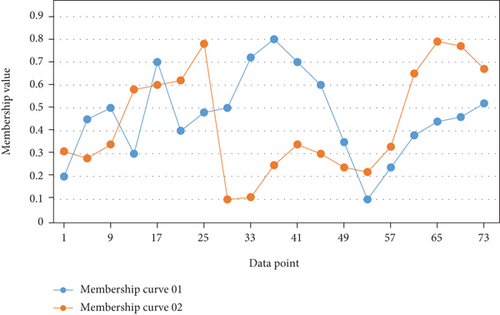
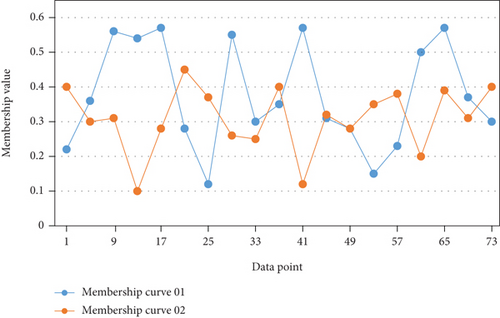
The degree of membership of the DFCM algorithm to the clusters of the IRIS dataset is displayed with a line graph, as shown in Figure 4.
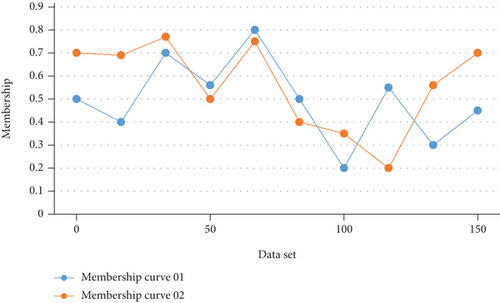
It is necessary to introduce the hard C-means HCM clustering algorithm first, because the fuzzy C-means clustering algorithm is developed from the hard C-means HCM (hard C-means) clustering algorithm.
The fuzzy C-means clustering algorithm (FCM) is a clustering algorithm that uses membership to define the degree of each data point belonging to a certain class.
It has been discovered that in team decision-making, decision-makers are frequently hesitant and indecisive, and that because they are unable to persuade one another, reaching a consensus on the final decision-making result is difficult. Grey theory is a mathematical tool for dealing with incomplete information that is similar to fuzzy set theory. The quality of decision-making in uncertainty decision analysis is usually uncertain due to the incompleteness and incompleteness of decision-making information, the professionalism of decision-makers, the dynamic process of decision-making, and differences in people’s understanding of goals. “Little data” and “poor information” grey uncertainty characteristics of “some information is known, and some information is unknown” characterize decision-making information. However, the traditional decision-making analysis method is incapable of resolving such issues. A grey fuzzy multiattribute decision-making problem is a multiattribute decision-making problem that contains both fuzziness and grayness in the real-world decision-making process. As the most recent extended form of fuzzy set, hesitant fuzzy set has its own set of benefits, which has piqued the interest of many academics. Grey decision theory was developed in the late 1980s and has since evolved into an inseparable core content in uncertain decision-making after a long period of development and accumulation. In reality, grey numbers, not interval numbers, are frequently used as hesitant fuzzy decision information. Grey fuzzy multiattribute decision-making problems are multiattribute decision-making problems that contain both fuzziness and grayness. Grey fuzzy set is not only a generalization of fuzzy set but also a generalization of grey set, and it is an organic combination of grey set and fuzzy set. Grey relational analysis is an analysis method that uses quantitative methods to evaluate the degree of association between things according to the similarity of the geometric shapes of the sequence curves of things. The degree of association reflects the similarity between the alternative evaluation scheme and the relatively optimal scheme, so as to form a criterion for evaluating the pros and cons of the program based on the degree of correlation, which is an objective evaluation method. Using the global optimization ability and parallelism of the genetic algorithm to automatically search for the best fuzzy parameters to realize the adaptive fuzzy enhancement algorithm, it is expected that the running time of the program will be reduced to be close to real-time application. The genetic algorithm processing results and evolution process are shown in Figures 5 and 6.
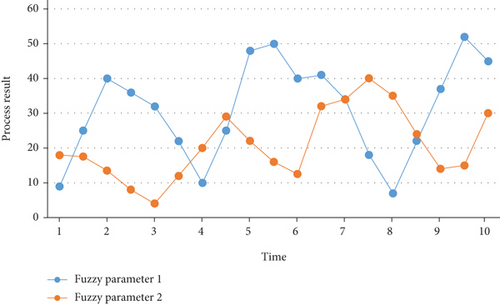
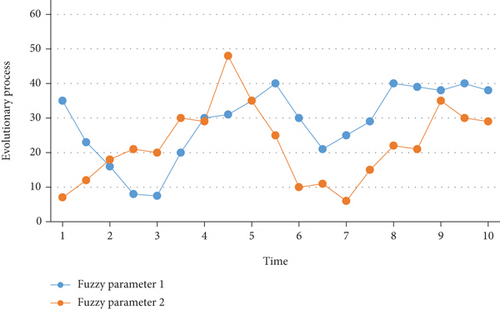
Decision-making information is frequently accompanied by grey characteristics, that is, decision-making information is represented by “little data” and “poor information” with “part of the information known and part of the information unknown” due to varying degrees of human recognition. Grey numbers are frequently used to represent in this case. It is a good way to make a decision based on the degree of grey in a relationship.
The source of innovation is demand. Data mining technology [26] arose from the urgent need for humans to obtain useful knowledge from data. Rough set theory is a new mathematical tool for dealing with problems that are ambiguous and imprecise. In 1982, Polish mathematician Z.P. Wlak proposed it for the first time. Rough set is a mathematical tool for describing incompleteness and uncertainty that can be used to analyze and deal with imprecise, inconsistent, and incomplete data, as well as reveal hidden knowledge and potential laws. Rough set theory is a soft computing technique for dealing with ambiguous and imprecise information.
The general process of knowledge discovery is shown in Figure 7.
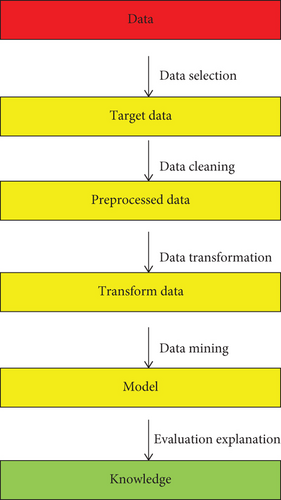
It organically integrates two important ways of thinking, granular cognition and approximation reasoning in the process of human problem solving, and can efficiently solve problems such as classification prediction and association analysis. At present, the theory has been successfully applied in the territories of data mining, machine learning, pattern recognition, and decision analysis. Reduction is an important part of data mining and one of the core issues of rough set theory. Given a fuzzy information system, many fuzzy attribute reductions can be found, each with a different contribution to decision support. The steady and rapid development of computer hardware over the past few decades has led to a massive supply of powerful computers, data collection devices, and storage media. Based on the similarity measure between objects in the interval information system, a fuzzy compatibility relation is defined on the universe of discourse, and the upper and lower approximations of the decision class based on the fuzzy compatibility relation are given. Hybrid soft computing technology integrating fuzzy sets and rough sets has been successfully applied in many territories such as machine learning, pattern recognition, and image processing.
In some cases, data mining must first get the data from the data warehouse to the data mining library or data mart. In fuzzy rough set theory, the key is to figure out how to set up and use fuzzy attribute reduction. Many fuzzy attribute reductions can be found in a fuzzy information system, each contributing differently to decision support. “Data-rich but information-poor,” as the vast amount of data has been described. Because of the complexity of the data in the knowledge base, not all object sets in a given knowledge base can be accurately expressed with knowledge. As a result, such subsets are frequently referred to as. It can only be roughly defined by knowledge through two precise categories, namely, upper and lower approximation sets, as a coarse category, that is, imprecise or approximate category. The complexity and uncertainty of data continue to rise as information technology advances and large-scale databases become more widely used. Effective tools to deal with these uncertain data are required to extract knowledge from complex information systems. Even if it is the most important fuzzy attribute reduction, if only one fuzzy attribute reduction is used to generate decision rules, the useful information hidden in other fuzzy attribute reductions will inevitably be lost. In rough set theory, knowledge is primarily expressed as an information system, and the knowledge pattern expressed by the information system is finally expressed through attributes.
4.2. Decision Tree Algorithm
4.2.1. Applicable Objects and Processes of Ordered Decision Trees
With the improvement of control requirements, computer technology has gradually penetrated into the territory of control. Among them, the most prominent ones include the use of fuzzy neural network and other intelligent technologies to solve nonlinear model identification and adaptive control problems in control. Data mining refers to the use of some analytical tool extract hidden, unknown, and valuable information from a large amount of incomplete, fuzzy, noisy, and random data. Decision tree technology is used in classification and prediction. Decision tree is a way to classify data. It mainly summarizes and infers some disordered and unruled things into a decision tree to classify them. A good subset of features in ordered classification should contain features that have high monotonic consistency with the decision class and are uncorrelated with the rest of the features in the set.
Compared with the data mining system in the traditional sense, the ordinal rule mining system has both its generality and its particularity. The generality is that it includes data selection, data preprocessing, and data transformation that are common to traditional data mining systems, data mining, interpretation, and evaluation. The uniqueness lies in the fact that, due to the order relationship between the attributes of the objects, traditional data mining algorithms cannot be applied directly to the data, necessitating data transformation, semantic information introduction, and transformation into Information data. When selecting the extended attribute in the ordered classification problem, the existing ordered decision tree induction algorithm selects the attribute with the largest ordered mutual information of the conditional attribute and the decision attribute, and ignores the attribute’s information distribution. There are many values, orders, and correlations between attributes, resulting in repeated selection of an attribute as an extended attribute, causing the classifier’s classification effect to be poor and the test set’s accuracy to be low. When classifying it, you can start at the bottom and work your way up, finding the properties of the test object, walking in the correct order, and finally arriving at the leaf node. Ordered mutual information is defined by the ordinal of the set rather than the cardinality, taking into account the ordered structure between datasets and inheriting both the robustness and the monotonicity in classification of classical mutual information. The order structure between objects is taken into account by information entropy, which is a robust uncertainty statistic.
(1) Ordered Decision Tree Based on Sort Entropy. There is an order relationship between the condition attribute and the decision attribute of the decision task, that is to say, the values of the condition attribute and the decision attribute in the database are in order. Decision tree learning algorithm is a method of approximating a discrete-valued objective function, which obtains a decision tree through training and learning. Monotonic classification is an important classification task in which monotonicity constraints between conditional attributes and decisions need to be considered: when an object’s values on all conditional attributes are no worse than another object, its decision nor is it worse than another object’s decision. The ordered decision tree overcomes the disadvantage that the traditional information entropy cannot reflect the ordered structure information and can generate a monotonic decision tree when the dataset is monotonic.
There are many methods and techniques of data mining, such as decision tree model method, support vector machine method, vector space model method, Bayesian network, neural network method, and rule induction. Among them, the decision tree model is the most commonly used method, mainly used for model prediction. Decision tree learning is an old nanoinference algorithm that is widely used in the territory of data mining. It learns and trains on known data to obtain a tree that shows the internal relationship of the data and then obtains decision rules and realizes data. For classification, ordered classification is also known as monotonic classification in the territory of machine learning. The objects it processes have an order relationship between their eigenvalues and decisions, and decisions that require good eigenvalue samples should not be classified into relatively bad decision categories. Monotonic classification is an important classification task in machine learning and pattern recognition, where monotonicity constraints between features and decisions must be considered. As can be seen, the ordered classification industry is a classification issue that affects a large number of countries. For example, in the search engine classification of online shopping, the system will sort and classify the items according to the sales volume (large, medium, and small) and price (high, medium, nad low) of the item, as well as popularity (high, medium, and low), credit (good, general, and poor), and other factors. Because the generated fuzzy rules are related to uncertainty in the fuzzy environment, the generated rules’ uncertainty also becomes a heuristic mode. The decision tree method starts by creating a decision tree and then applying it to the dataset. The research work mainly focuses on how to construct the decision tree effectively. An important way to deal with the ordered classification problem is to construct an ordered decision tree, and the core of constructing an ordered decision tree is the selection of extended attributes. The most suitable solution at present is to use a hash table to split the split attribute and record the branch node to which each record belongs, and continue to do so if there is enough memory.
5. Conclusions
The planning and design of tourism itineraries is a major focus of current tourism itinerary research. It has become a difficult point in current tourism itinerary optimization research because of the large amount of information on tourism-related elements and the lack of quantitative data. Travel recommendation relies heavily on data mining and recommendation technology. Smart travel route personalized recommendation technology is in high demand in the current travel industry, and it is also a hotbed of academic and commercial activity. In recent years, customer value and pricing strategy have become hot research topics in marketing. These theoretical insights can be applied to the field of tourism research, particularly to the study of travel routes for travel agencies with growth potential. Although data mining technology, location-based service (LBS), GPS trajectory mining technology, point of interest recommendation technology, and other related technologies and basic theories can be used for travel recommendation, these technologies still have flaws. Many practical factors must be considered in real-world tourism route planning activities, so there is still much work to be done in this area in the future.
Conflicts of Interest
The author does not have any possible conflicts of interest.
Acknowledgments
The study was supported by “Young Backbone Teachers Project of Colleges and Universities in Henan Province, China (Grant No. 2019GGJS260)”.
Open Research
Data Availability
The data used to support the findings of this study are included within the article.



